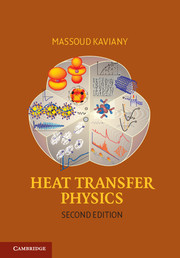Book contents
- Frontmatter
- Dedication
- Contents
- Preface
- Acknowledgments
- 1 Introduction and Preliminaries
- 2 Molecular Orbitals/Potentials/Dynamics and Quantum Energy States
- 3 Carrier Energy Transport and Transformation Theories
- 4 Phonon Energy Storage, Transport, and Transformation Kinetics
- 5 Electron Energy Storage, Transport, and Transformation Kinetics
- 6 Fluid Particle Energy Storage, Transport, and Transformation Kinetics
- 7 Photon Energy Storage, Transport, and Transformation Kinetics
- APPENDIX A Tables of Properties and Universal Constants
- APPENDIX B Derivation of Green–Kubo Relation
- APPENDIX C Derivation of Minimum Phonon Conductivity Relations
- APPENDIX D Derivation of Phonon Boundary Resistance
- APPENDIX E Derivation of Fermi Golden Rule
- APPENDIX F Derivation of Equilibrium, Particle Probability Distribution Functions
- APPENDIX G Phonon Contributions to the Seebeck Coefficient
- APPENDIX H Monte Carlo Method for Carrier Transport
- APPENDIX I Ladder Operators
- Nomenclature
- Abbreviations
- Glossary
- References
- Index
2 - Molecular Orbitals/Potentials/Dynamics and Quantum Energy States
Published online by Cambridge University Press: 05 June 2014
- Frontmatter
- Dedication
- Contents
- Preface
- Acknowledgments
- 1 Introduction and Preliminaries
- 2 Molecular Orbitals/Potentials/Dynamics and Quantum Energy States
- 3 Carrier Energy Transport and Transformation Theories
- 4 Phonon Energy Storage, Transport, and Transformation Kinetics
- 5 Electron Energy Storage, Transport, and Transformation Kinetics
- 6 Fluid Particle Energy Storage, Transport, and Transformation Kinetics
- 7 Photon Energy Storage, Transport, and Transformation Kinetics
- APPENDIX A Tables of Properties and Universal Constants
- APPENDIX B Derivation of Green–Kubo Relation
- APPENDIX C Derivation of Minimum Phonon Conductivity Relations
- APPENDIX D Derivation of Phonon Boundary Resistance
- APPENDIX E Derivation of Fermi Golden Rule
- APPENDIX F Derivation of Equilibrium, Particle Probability Distribution Functions
- APPENDIX G Phonon Contributions to the Seebeck Coefficient
- APPENDIX H Monte Carlo Method for Carrier Transport
- APPENDIX I Ladder Operators
- Nomenclature
- Abbreviations
- Glossary
- References
- Index
Summary
Energy is stored within atoms (electrons and relativistic effects) and in the bonds among them when they form molecules, and also between these molecules when they form clusters and bulk materials. In this chapter we review the intraatomic and interatomic forces and energies (potentials). We examine electron orbitals of atoms and molecules and review ab initio computations of interatomic potentials and potential models. Then we discuss the dynamics (and scales) of molecular (or particle) interactions in classical (Newtonian and Hamiltonian) treatments of multibody dynamics and the relationship between the microscopic and macroscopic states (particle ensembles). We also begin examining the quantum energy states of the simple harmonic oscillator, free-electron gas, and electrons in hydrogen atom orbitals, by seeking exact solutions to the Schrödinger equation.
Interatomic Forces and Potential Wells
Atoms and molecules, at sufficiently low temperatures, can aggregate into linked structures that form what we know as the condensed phases of matter. What causes this aggregation behavior are the attractive forces generated by the opposite electrical charges of each particle (be it individual atom, ion, or polar molecule) in the system. These forces are in turn caused by the innate charges of the constituent subatomic particles of each atom, ion, or molecule. All physical and chemical bonding is the result of such molecular forces that are electrical in origin (the Coulomb forces). Intramolecular (or interatomic) forces keep atoms in a molecule (a compound of atoms) together, such as the H−O bond in a H2O molecule, whereas intermolecular forces keep neighboring molecules together, such as H2O molecules in the gas, liquid, or solid phase.
- Type
- Chapter
- Information
- Heat Transfer Physics , pp. 50 - 118Publisher: Cambridge University PressPrint publication year: 2014



